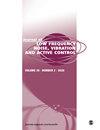Unsupervised structural damage detection based on an improved generative adversarial network and cloud model
IF 2.4
4区 工程技术
Q1 ACOUSTICS
Journal of Low Frequency Noise Vibration and Active Control
Pub Date : 2023-01-12
DOI:10.1177/14613484221150804
引用次数: 0
Abstract
The measurements derived from damaged conditions are difficult to acquire in actual structures, which limits the applicability of supervised damage detection methods. In this study, an unsupervised damage detection method that leverages an improved generative adversarial network (IGAN) and cloud model (CM) is proposed. This method only needs the data in the healthy state of the structure for model training, which can solve the above problems. Firstly, an IGAN model is established, which uses the encoder-decoder-encoder generative network to encode, reconstruct and re-encode the structural response in healthy state. The essential features hidden in complex data are learned by minimizing the distance between the real response and the reconstructed response, and the distance between the latent vectors obtained after two different encodings. During the test phase, when unknown state data is input into the model, the differences of the latent features of the two different codes can be used to preliminarily judge whether the structure is damaged. In addition, CM theory is used to further quantify structural damage and solve the problem of damage misjudgment caused by measurement noise, model parameters, feature selection, and other uncertain factors. The effectiveness of the proposed damage detection method is verified by Phase I IASC-ASCE benchmark structure and a bridge health monitoring benchmark model. The results prove that the proposed method can accurately detect the damage that has occurred.基于改进生成对抗网络和云模型的无监督结构损伤检测
在实际结构中很难获得损伤状态下的测量结果,这限制了监督损伤检测方法的适用性。在这项研究中,提出了一种利用改进的生成对抗网络(IGAN)和云模型(CM)的无监督损伤检测方法。该方法只需要结构健康状态的数据就可以进行模型训练,解决了上述问题。首先,建立IGAN模型,利用编码器-解码器-编码器生成网络对健康状态下的结构响应进行编码、重构和再编码;通过最小化真实响应与重构响应之间的距离,以及两种不同编码后获得的潜在向量之间的距离,来学习隐藏在复杂数据中的本质特征。在测试阶段,当模型中输入未知状态数据时,可以利用两种不同编码的潜在特征的差异来初步判断结构是否受损。此外,利用CM理论进一步对结构损伤进行量化,解决了测量噪声、模型参数、特征选择等不确定因素导致的损伤误判问题。通过一期IASC-ASCE基准结构和桥梁健康监测基准模型验证了所提出的损伤检测方法的有效性。结果表明,该方法能够准确地检测出已发生的损伤。
本文章由计算机程序翻译,如有差异,请以英文原文为准。
求助全文
约1分钟内获得全文
求助全文
来源期刊

Journal of Low Frequency Noise Vibration and Active Control
Engineering-Mechanical Engineering
CiteScore
4.90
自引率
4.30%
发文量
98
审稿时长
15 weeks
期刊介绍:
Journal of Low Frequency Noise, Vibration & Active Control is a peer-reviewed, open access journal, bringing together material which otherwise would be scattered. The journal is the cornerstone of the creation of a unified corpus of knowledge on the subject.
 求助内容:
求助内容: 应助结果提醒方式:
应助结果提醒方式:


